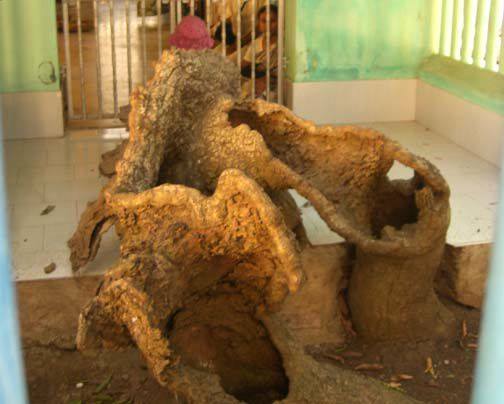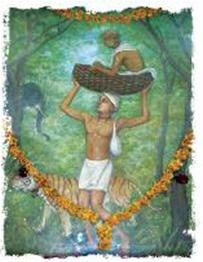The Origin of the Siddha-Bakula Tree:
In the sacred courtyard of Jagannath Puri, the unique bakula tree is renowned as the Siddha-Bakula tree. Each morning, the Pujaris would offer three twigs from a kumbhatua tree as danta-kastha (toothbrushes) to Lord Jagannath, Baladeva, and Subhadra. One day, however, a twig from the kumbhatua tree was missing. In its place, a twig from a bakula tree was used and later offered to Mahaprabhu as Maha-prasadam.
The Divine Transformation:
Gauranga Mahaprabhu, upon receiving the maha-prasadi bakula twig, planted it in the garden near Haridasa Thakura’s residence. This twig soon grew into a lush tree that provided cool shade and became a place where Haridasa Thakura performed his devotional bhajana.
The Miracle of the Bakula Tree:
After the departure of Haridasa Thakura, the tree continued to be revered by Srila Jagannatha Goswami, who also performed bhajana under it. One day, the king’s officers arrived to cut down the bakula tree, intending to use its sturdy trunk for making wheels for Lord Jagannath’s chariot. Jagannatha Goswami, aware of the tree’s sacred nature, protested, explaining its divine significance due to its connection with Mahaprabhu and Haridasa Thakura.
The next day, the officers were astonished to find the tree had undergone a miraculous transformation. The main trunk had turned as hard as rock, while the rest of the tree was hollow and twisted like a snake, rendering it useless for their purpose. Despite its unusual appearance, the bakula tree continued to thrive, demonstrating its divine protection and sanctity.
The Festival of Danta-Kastha-Ropana Mahotsava:
The bakula tree’s miraculous nature earned it the title Siddha-Bakula tree. Each year on Chaitra Sankranti (April), the locals celebrate the Danta-Kastha-Ropana Mahotsava, the festival commemorating the planting of the sacred wooden toothbrush. During this festival, devotees bathe the Siddha-Bakula tree with 108 pots of water and sing bhajans glorifying Gauranga Mahaprabhu and His esteemed devotee, Haridasa Thakura.
Lessons to Be Learned:
- Divine Connection: The story illustrates that objects and places intimately connected with the Lord and His devotees are imbued with divine sanctity and can perform miraculous deeds.
- Reverence and Devotion: Respect and devotion towards sacred objects and places enhance their divine significance and protect them from desecration.
- Power of Maha-Prasadam: The sanctity of maha-prasadam (food offered to the Lord) transforms even ordinary items into objects of great spiritual power.
Teachings from Srila Prabhupada’s Books:
- Bhagavad-gita As It Is, 9.22: “To those who are constantly devoted and who worship Me with love, I give the understanding by which they can come to Me.” Srila Prabhupada emphasizes the significance of devotion and love in receiving divine grace.
- Srimad Bhagavatam 1.2.6: “The Absolute Truth is the Personality of Godhead, and everything else is a reflection of His greatness. Those who are devoted to Him are protected by His divine will.” This verse highlights the protective and transformative power of devotional connection.
Prayer:
“O Lord Jagannath, Gauranga Mahaprabhu, and Namacharya Haridasa Thakura, please bless us with the purity of devotion that the Siddha-Bakula tree represents. May we always revere and respect the sacred objects and places connected to Your divine pastimes. Grant us the understanding to recognize and honor Your divine presence in all that we encounter. Siddha-Bakula ki Jai! Namacharya Haridasa Thakura ki Jai!”



